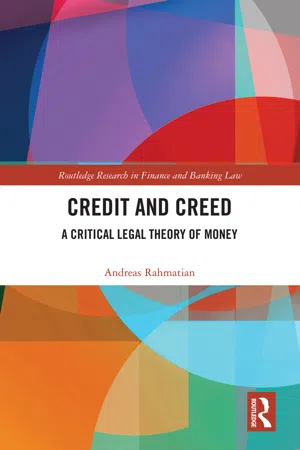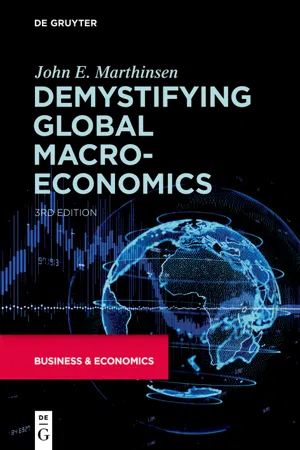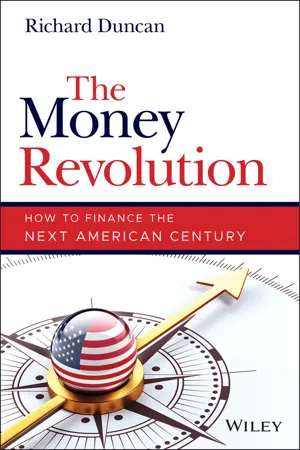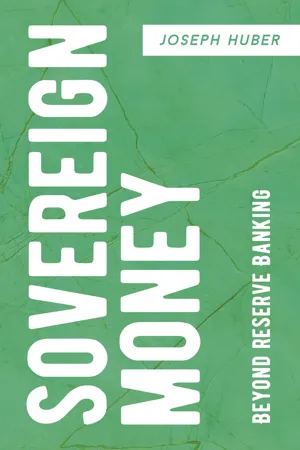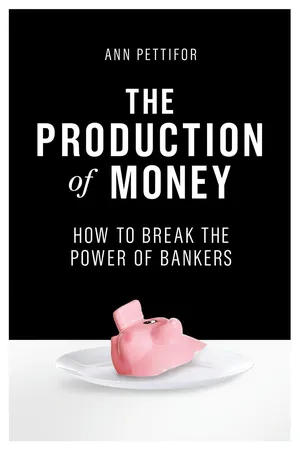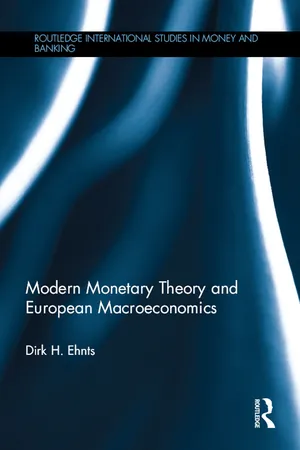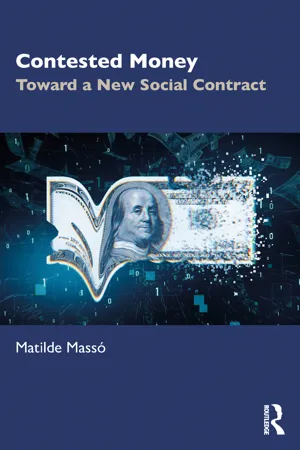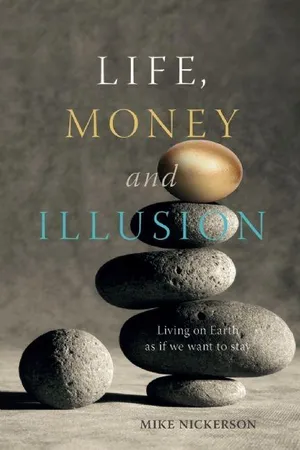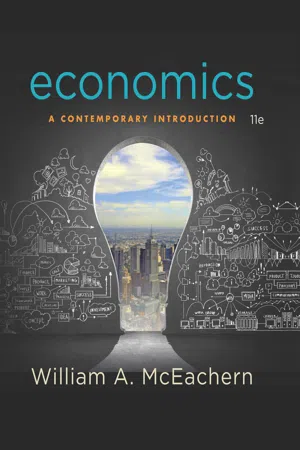Economics
Money Creation
Money creation refers to the process by which the banking system generates new money through the issuance of loans. When a bank extends a loan, it effectively creates new money by increasing the borrower's deposit balance. This expansion of the money supply plays a crucial role in stimulating economic activity and influencing overall price levels.
Written by Perlego with AI-assistance
Related key terms
1 of 5
12 Key excerpts on "Money Creation"
- eBook - ePub
Credit and Creed
A Critical Legal Theory of Money
- Andreas Rahmatian(Author)
- 2019(Publication Date)
- Routledge(Publisher)
31 but it does not explain properly the Money Creation process and should not be given too much emphasis.27 Bank of England (2014a: 14–15).28 Werner (2016: 370).29 Howells and Bain (2005: 241).30 Bank of England (2014a: 15).31 See e.g. Crowther (1946: 45). See also below under sec. 3(b).(c) Credit creation theory of moneyThe credit creation theory of money denies any correlation between money in depositors’ deposits and money provided by loans and therefore emphasises that banks do not use customers’ deposits to grant loans. In contrast, banks create money by giving credit: ‘Whenever a bank makes a loan, it simultaneously creates a matching deposit in the borrower’s bank account, thereby creating new money’.32 Banks are not financial intermediaries at all, neither individually (financial intermediation theory) nor in aggregate (fractional reserve theory). Schum-peter describes the Money Creation process in this way:33It is much more realistic to say that the banks ‘create credit’, that is, that they create deposits in their act of lending, than to say that they lend deposits that have been entrusted to them…. The theory to which economists clung so tenaciously makes [depositors] out to be savers when they neither save nor intend to do so; it attributes to them an influence on the ‘supply of credit’ which they do not have.The credit creation theory is not the newest of the three theories of money supply; it can rather be traced back to the nineteenth century and was only eclipsed by the other two theories, particularly after the Second World War. In the eighteenth century, ‘credit’ was still associated with moral ideas of ‘trust’ and ‘confidence’ between businessmen, not just with legal claim or debt, for example in the Essay on Credit by Pelatiah Webster of Philadelphia (1786):34 - eBook - PDF
Economics
Theory and Practice
- Patrick J. Welch, Gerry F. Welch(Authors)
- 2016(Publication Date)
- Wiley(Publisher)
Although these loan‐making institu- tions include savings associations and credit unions, it is the commercial banks that are primarily engaged in Money Creation and destruction. Because of the huge impact that 2 Some economists write the equation of exchange as an identity: MV PQ . This equation is so classic that it was for years the license plate of a money and banking professor in St. Louis. 3 In reality, the velocity of money (M1) does change over time. However, in looking at the effect on the economy of increasing or decreasing the money supply at a particular moment in time, the assumption that V is fixed is appropriate. 206 Chapter 8 Money Creation, Monetary Theory, and Monetary Policy money supply changes have on the economy, it is important that the capacity of finan- cial institutions to make loans be highly controlled. This is one of the functions of the Federal Reserve. However, in order to understand how the Fed exerts its control over money supply changes, we need to understand under what conditions a financial depository institution can make a loan and how those conditions change. The Process of Money Creation Every financial depository institution has two assets that it counts as its actual reserves: the institution’s reserve account and its vault cash. Every institution must have a reserve account, which, as we saw in Chapter 7, can be held at a Federal Reserve bank or at an approved designated institution. Vault cash is all the cash in the depository institution’s vault and cash drawers. Depository institutions have a reserve requirement, which is a specific percent- age of deposits that must be kept as actual reserves. For example, a bank with a reserve requirement of 10 percent on demand deposits must have an amount on reserve equal to 10 percent of the value of the demand deposits it is holding. - eBook - PDF
- John E. Marthinsen(Author)
- 2020(Publication Date)
- De Gruyter(Publisher)
Chapter 8 Money Creation Using money is such a routine part of our daily lives that it is easy to overlook the fact that the creation of money is a business , which is conducted by financial institutions to make profits. Therefore, when central banks regulate their na-tions ’ money supplies, they also regulate financial intermediaries ’ profits. This chapter discusses the Money Creation powers of financial intermediar-ies. Because most nations have a wide variety of them (e.g., commercial banks, savings banks, credit unions, and other thrift institutions), we will focus on those financial intermediaries that take deposits and make loans . As a group, we will call them “ banks. ” One of the best ways to understand the money-creation process and the power a single bank possesses to create money is by analyzing the effect a loan has on the bank ’ s balance sheet and the nation ’ s money supply. From this discussion, it is a natural step to discuss the money-creation powers of the banking system 1 and how it amplifies the powers of a single bank. In Chapter 9, “ Central Banks, ” this foundation will be vital to understanding how central banks regulate financial intermediaries and, thereby, control their nations ’ money supplies. The Basics Creation of Money by a Single Bank Banks have the power to change a nation ’ s money supply. They do so by mak-ing loans and purchasing securities because these bank assets are paid for with newly created checking accounts or with cash from banks ’ vaults. Let ’ s trace the effects that loans and security purchases have on a bank ’ s balance sheet and then show the impact these changes have on a nation ’ s money supply. Figure 8.1 shows the balance sheet of First National Bank before making a loan. Notice that total assets equal $10,000 million, and the sum of the bank ’ s liabilities plus stockholders ’ equity also equals $10,000 million. - eBook - PDF
The Money Revolution
How to Finance the Next American Century
- Richard Duncan(Author)
- 2022(Publication Date)
- Wiley(Publisher)
This chapter will show that the Fed also controls the amount of credit that the banking system can create. This power is of crucial importance to the conduct of monetary policy and to the economy because, under normal circumstances, the banking sys-tem creates a great deal more credit than the Fed does. For that Credit Creation by the Banking System 130 Credit reason, the Fed generally achieves its policy objectives by influ-encing the volume of bank credit. This chapter begins by explaining how the banking system creates credit. Next it describes the tools and methods the Fed employs to control the amount of credit the banking system cre-ates. Finally, it shows that over time the Fed steadily revised its regulations to enable the banking system to create ever larger amounts of credit in order to stimulate economic growth. Eventu-ally, these changes facilitated the creation of so much credit that credit growth became the most important driver of economic growth, fundamentally transforming the nature of our eco-nomic system. Subsequent chapters will show that economic growth became dependent on credit growth, which explains why the Fed is so desperate to ensure that credit continues to expand. The Fed understands that credit growth drives the economy and that if credit contracts there will be a depression. Commercial Banks Create Money, Too Part One described how the Fed creates money. But, the Fed is not alone in its ability to create money. The commercial bank-ing system also creates money by extending loans and creating deposits. The deposits that individuals, businesses, and other entities hold in commercial banks are considered to be a sec-ond kind of money because deposits can be withdrawn as cash and spent, or they can be spent simply by writing a check on a deposit in a checking account. The money that a central bank creates is called base money or the monetary base. - eBook - PDF
Sovereign Money
Beyond Reserve Banking
- Joseph Huber(Author)
- 2016(Publication Date)
- Palgrave Macmillan(Publisher)
This may result in a balance sheet crisis rather than the rule reliably function- ing as a liquidity buffer. Seen from a bank’s point of view, all such restrictions in fact curb their potential for credit and deposit creation. However, the hindrance is short- rather than long-term. By cooperative credit and deposit creation, the bank- ing industry, supported by quasi-automated fractional refinancing of the central banks, creates for itself what it needs in order to extend the limits and fulfill the requirements, by building up equity, providing sufficient liquidity, acquiring enough collateral and so forth. The ‘masters of the universe’ will not create what it needs in six days and rest on the seventh. But they might be able to do it in seven months or a couple of years. As a result, the ability of the banking sector to extend credit and create bankmoney seems to be limitless in the long term. Not quite. As will be seen in chapter 5 on the dysfunctions of the bankmoney regime, real eco- nomic output will always be a gravitational limit that cannot arbitrarily be outsmarted. Banks and financial markets can overshoot that mark and in fact they recurrently do. It regularly proves to be unsustainable, resulting in vio- lent self-corrections of the markets, and in general crises causing damage to the entire economy and population. 4.9 Creation of Bankmoney: The Entire Picture So far, we have discussed how a bank creates bankmoney by making loans and granting overdrafts. It has not yet been discussed that banks also create bank- money when they purchase financial and real assets for their own account, such as securities, equity and real estate, also including office equipment, IT infrastructure, software, company cars, licences and so on, all items which are entered into the books as tangible or intangible assets. 24 Securities may gain or lose value, and the equipment and other durables are subject to scheduled write-down. - eBook - ePub
The Production of Money
How to Break the Power of Bankers
- Ann Pettifor(Author)
- 2017(Publication Date)
- Verso(Publisher)
private banking system. Rather than banks acting as intermediaries and lending out deposits that were placed with them, it is the act of lending itself that creates deposits or bank money, and is also a debt, the Bank’s staff explained. Of course this bank money is not actually printed by the private bank; only the central bank has the legal authority to print money and mint coins. The money created by a loan – bank money – is simply digitally transferred from one private bank account to another. The only evidence of its existence is in the numbers printed on a bank statement. Of the total amount of money created, only a tiny proportion is normally converted into tangible money in the form of notes and coins, or cash.For private commercial bankers operating within a monetary economy, the relevant consideration is not the availability of existing savings, but the viability of the borrower, her project, her collateral and the assessment of whether the project will generate income with which she can repay the credit/debt.And yes, the Bank of England confirmed that in a monetary economy the money multiplier (the percentage of deposits that banks are required to hold as reserves against lending) is an incorrect account of the lending process. Bank lending is not constrained by ‘reserves’. The assumption that banks hold reserves equal to a fraction of their lending – ‘fractional reserve banking’ – is wrong. Bank ‘reserves’ are not savings in the sense we understand them. They are resources (resembling an overdraft) made available only to the bankers licensed by the central bank. They are used to facilitate the ‘clearing’ process for settling deposits and liabilities between banks at the end of each day. Central bank reserves never leave the banking system to enter the real economy. While central bank reserves may help to free up the balance sheets of banks and other associated financial institutions, they cannot be used to lend on to firms or individuals in the non-bank economy. - eBook - ePub
Money
What It Is, How It's Created, Who Gets It, and Why It Matters
- Sergio M. Focardi(Author)
- 2018(Publication Date)
- Routledge(Publisher)
In summary, the endogenous Money Creation theory holds that money is created by commercial banks without the intervention of the central bank. The central bank intervenes only to provide reserves so that regulatory standards are met and it is possible to make transfers of funds between banks. In this view, banknotes play no role in the money generation process. Banknotes are supplied to individuals on demand but do not influence the total money generation process. An endogenous money generation process can start from zero with banks making loans and creating deposits. This is a fundamental difference with the verticalist theory which holds that the money generation process depends on exogenous money supplied by central banks and multiplied (but not created) by commercial banks. The main difference is given by the handling of reserves and by the role of currency.5.6 Other ways to create money
In addition to the creation of money or near-money that we have discussed thus far, there are additional ways to create purchasing power, including private credit and the issuing of digital currencies. The purchasing power thus created does not always qualify as money.5.6.1 Private creditWe have discussed the role of commercial banks in creating money by issuing loans. But commercial banks are not the only ones to accord credit or issue loans. There are two other commonly used ways to accord credit: commercial payment terms and peer-to-peer lending.In according payment terms to their business partners, firms extend credit to clients, thereby according them increased purchasing power. Consider, for example, clothing stores. Typically shops order goods well in advance of the season when products can be sold and, at the beginning of the season, keep inventory. Modern techniques of flexible production allow just-in-time delivery of products on short notice but, still, any clothing store must keep a minimum of inventory. It makes a difference if the supplier insists on being paid on delivery, within say 60 days, or only in the case of a sale, accepting to take back unsold inventory. By increasing the purchasing power of clients, commercial payment terms are loans and fulfill one of the key functions of money. However, firms that give favorable payment terms are using their own money or reducing their own credit and, ultimately, their own purchasing power. The sum of credit/ debt is zero. - eBook - PDF
- Irvin B. Tucker, Irvin Tucker(Authors)
- 2016(Publication Date)
- Cengage Learning EMEA(Publisher)
IN THIS CHAPTER, YOU WILL LEARN TO SOLVE THESE ECONOMICS PUZZLES: • Exactly how is money created in the economy? That is, how does the money supply increase? • What are the major tools the Federal Reserve uses to control the supply of money? • Why is there nothing “ federal ” about the federal funds rate? Copyright 2017 Cengage Learning. All Rights Reserved. May not be copied, scanned, or duplicated, in whole or in part. Due to electronic rights, some third party content may be suppressed from the eBook and/or eChapter(s). Editorial review has deemed that any suppressed content does not materially affect the overall learning experience. Cengage Learning reserves the right to remove additional content at any time if subsequent rights restrictions require it. ............................................................................................................................................................................................. ............................................................................................................................................................................................. 15-1 Money Creation BEGINS In the Middle Ages, gold was the money of choice in most European nations. One of the problems with gold is that it is a heavy commodity, which makes it difficult to use in transactions or to hide from thieves. The medieval solution was to keep it safely depos-ited with the people who worked with gold, called goldsmiths . This demand for their ser-vices inspired goldsmith entrepreneurs to become the founders of modern-day banking. The goldsmiths sat on their benches with ledgers close by and recorded the amounts of gold placed in their vaults. In fact, the word bank is derived from the Italian word for bench, which is banco . After assessing the purity of the gold, a goldsmith issued a receipt to the customer for the amount of gold deposited. - Dirk H. Ehnts(Author)
- 2016(Publication Date)
- Routledge(Publisher)
In the same way, any scarcity of bank deposits can be cured by the creation of additional bank deposits. The question is which institution is entitled to do that, and which rules shape the process. The whole setup resembles the scorekeeping system of a football game. In a modern stadium, the digital scoreboard can display an unlimited amount of digits. Even a score in the triple digits would be easy to show. On the other hand, the existence of a digital scoreboard does not increase the number of goals just The creation of central bank deposits 81 because it is easier to display them! The result of the game is independent from the nature of the display. A central bank is like the warden of the game-score; the monetary system is a scorekeeping system for credits and debts (or assets and liabilities), nothing else and nothing more. On its spreadsheet, the central bank can theoretically grant unlimited deposits, but in practice this is not allowed. The problem of deflation, for instance, is not generated by a central bank ‘running out of money’. Neither the amount of printed bank notes and minted coins nor the amount of virtual money in the form of bank deposits is limited in any physical way. What is limited are the available or retrievable resources, available labour-hours and achievable supplies of products and services in a given time-frame. The mere statement that banks and central banks can create unlimited amounts of deposits does not mean that they should aim at unlimited credit cre- ation or tolerate it. Likewise, it is not useful to demand the repayment or reduc- tion of all debts. The monetary system fulfils a particular purpose: it facilitates the production of goods and services and their distribution. To reach this goal, it’s reasonable to establish intermediate goals for monetary ratios, flows and aggregates, but these should not be cast in stone.- eBook - ePub
Contested Money
Toward a New Social Contract
- Matilde Massó(Author)
- 2023(Publication Date)
- Routledge(Publisher)
Laidler, 1981 ).3.3 The Fundamentals of Credit Money Approaches
At this point, two important questions arise: How is money created in contemporary economies and what is the process that allows money to incorporate value? Since money is essentially debt, any attempt to analyze its functioning should also consider the institutional arrangements that facilitate its creation and operation. In doing so, the aim is not to identify an invariant or universal explanation of how money works but instead to understand how it works in current capitalist market economies (Weber, 2018 ).The foundation to understand how money works can be found in Keynesian and heterodox traditions. Partly in line with Ingham (2004) , two relevant approaches are explored in order to render as complete a picture as possible of those elementary aspects of contemporary money. First, money consists of a claim or credit; and second, the state or political authority is an essential actor in the monetary system.3.3.1 Money, Credit, and Lending Activity
The conception of money as debt developed late in economic history. Chapter 1 described how all monetary economies—not only the most financially evolved—have a basic credit element (Smithin, 2003 ). However, literature on money and credit remained separate areas within the literature on general economics (Schumpeter, 1994 [1954], p. 1111).According to Schumpeter (1994 [1954], p. 285), the early roots of the credit money approach can be found in the monetary analysis of Johann Becher (1635–1682), François Quesnay (1694–1774), and the antimetallist literature of Nicholas Barbon (1640–1698) in the 17th and the 18th century. More recently, we can trace this conception of credit money to the 19th -century literature of the banking and currency school in England, and the historical controversy among greenbackers and bullionists in the US literature from the 1860s and 1870s onward (see Carruthers & Babb, 1996 - eBook - PDF
Life, Money and Illusion
Living on Earth as if we want to stay
- Mike Nickerson(Author)
- 2009(Publication Date)
- New Society Publishers(Publisher)
It works the same in all capitalist countries. Lord Josiah Stamp, a former director of the Bank of England, issued a clear warning in a public address in 1937: The modern banking system manufactures money out of nothing. The process is perhaps the most astounding piece of sleight of hand that was ever invented. Banking was conceived in iniquity and born in sin. Bankers own the earth; take it away from them, but leave them with the power to create credit, and with the stroke of a pen they will create enough money to buy it back again .... If you want to be slaves to the bankers, and pay the costs of your own slavery, then let the banks create money. It is a “mighty privilege,” wrote Bishop Berkeley in 1763, “for a man to create a hundred pounds with the stroke of a pen.” With our global economy crippled by debt, and seeking relief from its bottomless obligations by expanding the volumes of resources it turns into garbage, it is perhaps time to ask if this privilege is well-appointed. Debt-Money and Inflation The classic cause of inflation is more money in circulation than is necessary to purchase available goods and services. People push prices up as they compete to buy limited stocks. While excess money in circulation has received the blame for recent bouts of inflation, when that money is laden by debt another factor takes over. Looking back on the big deficit/inflation scare of the early 1980s, do you recall stores with empty shelves or car dealerships unable to find vehicles for eager customers? Goods, rather than being too few, remained abundant. - eBook - PDF
Economics
A Contemporary Introduction
- William A. McEachern(Author)
- 2016(Publication Date)
- Cengage Learning EMEA(Publisher)
Now that you have some idea how fractional reserve banking works, we are in a position to summarize the Federal Reserve’s role in the economy. C H E C K P O I N T How do banks create money? Copyright 2017 Cengage Learning. All Rights Reserved. May not be copied, scanned, or duplicated, in whole or in part. Due to electronic rights, some third party content may be suppressed from the eBook and/or eChapter(s). Editorial review has deemed that any suppressed content does not materially affect the overall learning experience. Cengage Learning reserves the right to remove additional content at any time if subsequent rights restrictions require it. Chapter 28 Banking and the Money Supply 653 28-4a Open-Market Operations and the Federal Funds Rate The Fed carries out open-market operations whenever it buys or sells U.S. government bonds in the open market. The term “open market” here means that securities dealers compete to do business with the Fed based on price in an open market. Decisions about open-market operations are made by the Federal Open Market Committee, or FOMC, which meets every six weeks and during emergencies. To increase the money supply, the Fed directs the New York Fed to buy U.S. bonds. This is called an open-market purchase. To reduce the money supply, the New York Fed is directed to carry out an open-market sale. Open-market operations are relatively easy to carry out. They require no change in laws or regulations and can be executed in any amount—large or small—chosen by the Fed. Their simplicity and ease of use make them the tool of choice for the Fed. Through open-market operations, the Fed influences bank reserves and the federal funds rate, which is the interest rate banks charge one another for borrowing excess reserves at the Fed, typically just for a day or two. Banks that need reserves can bor- row excess reserves from other banks, paying the federal funds rate of interest.
Index pages curate the most relevant extracts from our library of academic textbooks. They’ve been created using an in-house natural language model (NLM), each adding context and meaning to key research topics.
